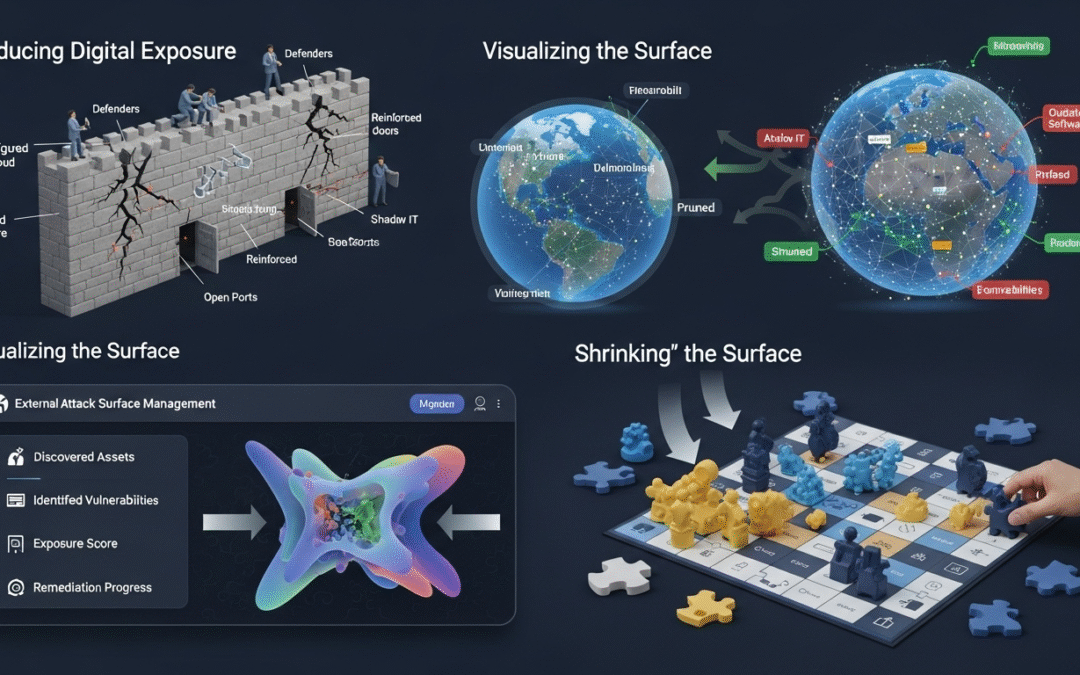Introduction: From Perimeter Defense to Digital Exposure Management
Historically, cybersecurity strategies were built around the concept of perimeter defense. In the late 1990s and early 2000s, organizations relied heavily on firewalls, antivirus software, and intrusion detection systems (IDS) to protect internal networks from external threats. These tools were designed for static environments, where assets were largely on-premises and centrally managed.
However, the rapid digitization of business operations, the rise of cloud computing, and the proliferation of shadow IT have dramatically expanded the digital attack surface. Today, organizations face a dynamic threat landscape where internet-facing assets—many of them unknown or unmanaged—pose significant risks. This shift has necessitated a new paradigm: External Attack Surface Management (EASM).
Evolution of EASM: A Strategic Framework
The Hacker News briefing outlines a four-pillar framework for effective EASM, reflecting the evolution from reactive asset management to proactive exposure reduction:
1. Discovery
Early asset discovery tools relied on static IP inventories and DNS sweeps. Modern EASM platforms now continuously identify cloud functions, APIs, and ephemeral services that legacy tools often miss.
2. Assessment
Risk-based scoring models integrated into SIEM platforms allow organizations to prioritize assets based on exploitability and business impact. This marks a shift from generic vulnerability scanning to contextual risk evaluation.
3. Remediation
Automated playbooks embedded in DevSecOps workflows enable rapid mitigation of misconfigurations, outdated services, and exposed environments. This automation is essential in fast-paced cloud deployments.
4. Monitoring
Continuous telemetry and machine learning models provide real-time visibility into attack surface changes. Unlike traditional vulnerability management, EASM emphasizes dynamic monitoring and behavioral baselining.
Technological Advancements and Toolsets
Modern EASM platforms incorporate a range of sophisticated tools:
- Continuous Scanning Engines: These cloud-native tools detect subdomain takeovers, certificate anomalies, and shadow IT.
- Attack Surface Intelligence Platforms: Graph-based systems visualize asset interconnectivity and assign risk scores.
- Cloud Security Posture Management (CSPM): CSPM tools flag misconfigurations and enforce zero-trust principles across cloud environments.
- Security Orchestration, Automation, and Response (SOAR): SOAR platforms automate remediation workflows, reducing response times and human error.
Implications for Data Professionals
The rise of EASM has profound implications for data professionals across roles:
- Security-Aware Data Discovery: Sensitive assets such as PII and proprietary models must be accurately tagged and inventoried across multi-cloud environments.
- Governance and Compliance: Data governance must align with EASM to meet evolving regulations like GDPR 2.0 and the U.S. Federal Data Security Act.
- Toolchain Modernization: Legacy perimeter-based security is insufficient. Engineers must embed security logic into ETL workflows, and analysts must operate in encrypted, secure environments.
- Executive Strategy: CIOs, CDOs, and CISOs must adopt a shared lexicon of exposure metrics and integrate cyber risk into strategic planning.
Historical Context: The Rise of Shadow IT
The emergence of shadow IT—unauthorized digital services and devices—has significantly complicated cybersecurity efforts. Initially seen as a fringe issue, shadow IT has become pervasive due to the rise of cloud services and remote work. Gartner predicted that by 2020, one-third of successful cyberattacks would target shadow IT resources. Today, shadow IT is a major contributor to digital exposure, often bypassing formal security protocols and creating invisible vulnerabilities.
Key Takeaways
- EASM is now a foundational component of cybersecurity, not a luxury.
- Continuous discovery and monitoring are essential to managing digital exposure.
- Automation, AI, and threat intelligence are central to modern EASM platforms.
- Data professionals must integrate security into every stage of data handling.
- Executive leadership must prioritize exposure metrics in strategic decision-making.
Conclusion: Building a Cyber-Resilient Future
As enterprise architecture shifts toward distributed, composable models, traditional security paradigms are no longer sufficient. Cybersecurity must be embedded across every dataset, API, and cloud service. The question is no longer whether vulnerabilities exist—but how quickly they can be identified and mitigated.
In the age of AI-scale data flows and sophisticated adversaries, EASM is not just a technical solution—it is a strategic imperative. Organizations that embrace continuous, intelligent exposure management will be better positioned to protect their assets, comply with regulations, and maintain trust in an increasingly digital world.
References
- CrowdStrike. (2024). What is Shadow IT? Defining Risks & Benefits. CrowdStrike
- TrustCloud. (2025). Taming Shadow IT: How We’re Tackling One of Cybersecurity’s Biggest Hidden Threats. TrustCloud
- TealTech. (2025). The Impact of Shadow IT on Cybersecurity. TealTech
- WebGuardianTech. (2025). The Evolution of Attack Surface Management: Past, Present, and Future. WebGuardianTech
- ZeroFox. (2024). The Evolution of External Attack Surface Management. ZeroFox
- Security Boulevard. (2024). Evolution of Attack Surface Management. Security Boulevard
- RiskProfiler. (2025). The Evolution of External Attack Surface Management in 2025. RiskProfiler
- Bitsight. (2025). Attack Surface Management Insights 2025 – KuppingerCole. Bitsight

